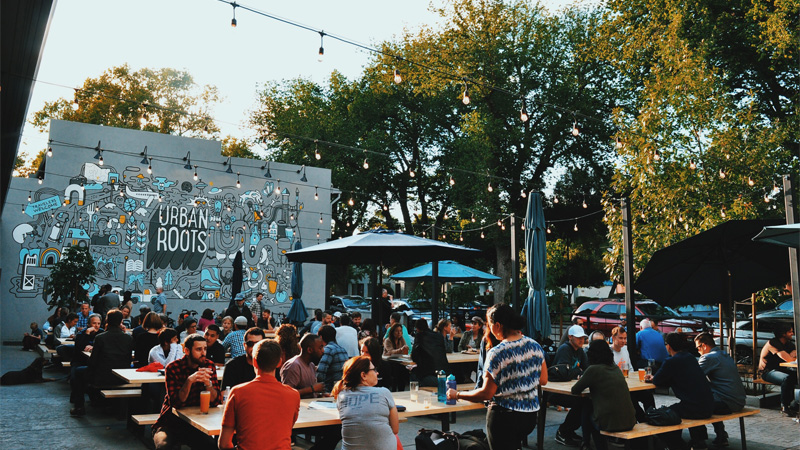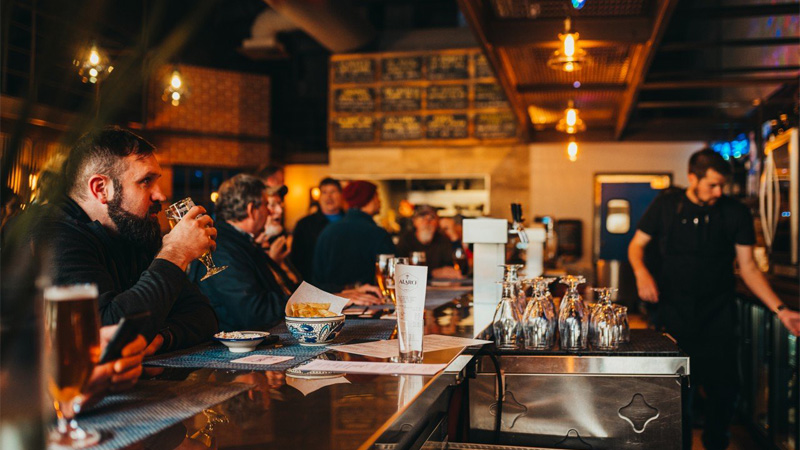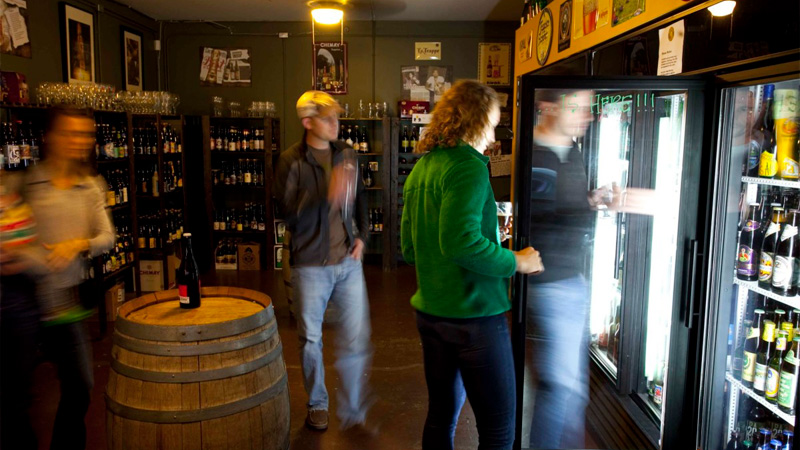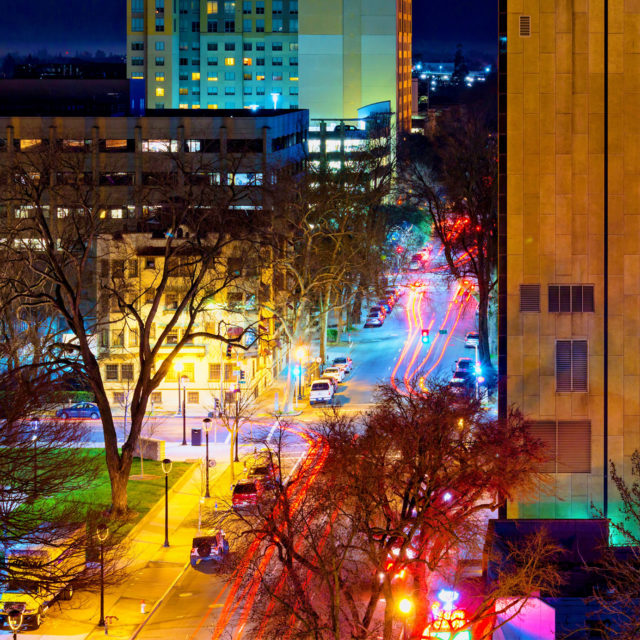People living in urban centers tend to sniff at the sameness of the suburbs, but these days, a lot of American cities look uncannily alike. There are Targets and Soulcycles as far as the eye can see, and an array of cookie-cutter coffee shops that vaguely resemble WeWorks.
“As corporate America has grown, you have these strip malls. You can pop into a city and not really know where you’re at, because these developments look so similar. They’re all selling the same things,” Rob Archie, co-founder of Urban Roots Brewery in Sacramento, Calif., says.
“But with beer, it’s different. You can go into a brewery and taste the region,” he adds, and points to Sacramento’s steadfastly local brewery scene as a prime example.
In Sacramento, very few breweries distribute their beers nationally. Instead, they prioritize their hyper-local markets, delivering kegs to nearby restaurants by request, and finding their next-door neighbors first in line on can release days.

It’s a throwback business model with refreshingly inclusive results. By focusing on their communities, Sacramento’s brewpubs provide the multi-generational and -cultural spaces absent from many American cities.
“The thing about Sacramento is, it’s a fairly big city with a very small-town feel,” Justin Chechourka, author, “Sacramento Beer Craft History,” says. “You’ve got some big-time producers like Knee Deep, which is available across the country. Track 7, same thing. But then we’ve also got the guys who are like, ‘Look, we’re just want to make beer for our neighborhood.’”
California’s capital is the third-largest city in the state and has one of the country’s most diverse populations. From 1950 to 1970, however, more than half of downtown residents moved to the suburbs, leaving blocks of industrial buildings that, until quite recently, remained unoccupied. “The city faced dire financial straits in the 1980s and 1990s, due to suburban flight and broad destabilization,” Cearra Cannon, a tour guide with Local Roots, says.
Now Sacramento is on an upswing, thanks to billions of dollars of urban reinvestment and an influx of arrivals from the overpriced barracks of the Bay Area. Beer is an economic driver, too.
In the last 10 years, the number of breweries in greater Sacramento has grown from nine to 70, according to the tourism board. This is not the only American city undergoing a beer-soaked revolution, of course; the Brewers Association reports nearly 80 percent of drinking-age Americans live within 10 miles of a brewery. But Sacramentans are especially proud of their beer scene. Some even feel it’s their birthright.
“Sacramento was the top hops-growing region before Prohibition. We had more breweries than any city in America other than Milwaukee,” Nick Leonti, director of tourism, Visit Sacramento, says. “And then Prohibition came along, and all those breweries had to shut down.”

While hops production has long since relocated to Oregon, Washington, and Idaho, the city’s agricultural identity remains strong, thanks to its proximity to U.C. Davis and the Sacramento Valley farmlands (the latter reported $507 million gross value in 2016). As a result, several Sacramentans casually use the term “farm to fork” to describe their locally inspired restaurants, and pride themselves on their admittedly exceptional Sunday farmers market.
Archie believes these agricultural ties helped propel the city’s resurgent craft beer scene. “Being one of the most diverse growing regions in the world you have great restaurants, great produce, so it makes sense you get really into fresh beer,” he says.
Local pride runs deep. “This town rallies around things. They rally around the Sacramento Kings when they’re good — actually, it doesn’t even matter if they’re good. The Kings sold out for like 15 straight years because the town just rallies around them,” Chechourka says. “The beer community does the same thing. What [beer] offers, in a lot of ways, is a new place to socialize, a new place to gather that wasn’t there before.”
One of the first spots to do so was Pangaea Bier Cafe, a beer-focused restaurant Archie opened in the Curtis Park neighborhood in 2008. It was inspired by the European brewpubs he visited while living in Italy as a professional basketball player.
“What’s interesting about breweries is there’s very few social places that multi-generations go. Bars are bars. Restaurants are restaurants. But at breweries you have 80-year-old couples, people who just turned 21, and young professionals, and they all genuinely think, ‘Yeah, we should go to that spot,’” Archie says, calling neighborhood brewpubs “another third place” in American cities.

A concept pioneered by sociologist Ray Ortenburg in 1989, “third places” are neutral locations where people gather that aren’t home or work. “England has pubs, France has cafes, and Austria has coffee houses,” Christopher Peterson, Ph.D., writes in Psychology Today. “Once upon a time in the United States, common third places included country stores, post offices, barber shops, hair salons, soda shops, and taverns.”
Thanks to its wealth of community-focused breweries, modern Sacramento has third spaces in spades. And unlike the taverns and beer gardens of bygone eras, which were almost exclusively patronized by white men, these brewpubs aim to welcome all their neighbors.
“We are producing beer for our local community here,” Alaro Brewing Company’s Ray Ballestero says. “I think that any community and any neighborhood can support their own neighborhood brewery, and that’s a beautiful thing.”
A short walk from Urban Roots and At Ease, a microbrewery opened by a U.S. Army colonel-turned-UC Davis master brewer last year, Alaro specializes in classic beer styles. Its Castillo IPA won a Gold Medal at the 2018 Great American Beer Festival less than three months after the brewery opened.
Like Archie, Ballestero and his wife and co-owner, Annette, are inspired by European brewpubs. “When you travel through different parts of Europe … you go through each village or town, and each one has its own brewery, its own bakery, its own cheese, and you can smell the meats curing. The flavors and the profiles are different in every town and neighborhood. I think that’s really cool,” Ballestero says. He sources local barley for his saison, and Alaro’s Sacramento Pale Ale features organic malt grown at UC Davis.
Notably, not one brewery in the city limits has corporate ownership. In fact, when AB InBev-owned Golden Road opened a taproom downtown in 2018, the Sacramento Brewers Guild called it “faux craft beer” and neighbors filed enough noise complaints that it had to change its hours. It closed earlier this year due to a fire, but a spokesperson for the brand says the company does plan to reopen it after a remodel.
“We have almost 80 breweries here in a small area, and it’s super competitive” from a business perspective, Ballestero says; but there’s camaraderie among Sacramento’s hometown brewers. If a hops delivery doesn’t come in to Alaro, for example, “I can call up one of our neighboring breweries and say, ‘Do you guys have any Mosaic we can borrow?’ And they’re like, ‘Absolutely. Do you want us to bring it over?’”
Archie calls this commitment to community “fresh beer with a soul behind it,” and says, “It’s here to stay. It’s not going anywhere.” Let the corporate buyouts, private investment, and endless expansion make headlines. Beers with soul make history.
This story is a part of VP Pro, our free platform and newsletter for drinks industry professionals, covering wine, beer, liquor, and beyond. Sign up for VP Pro now!
